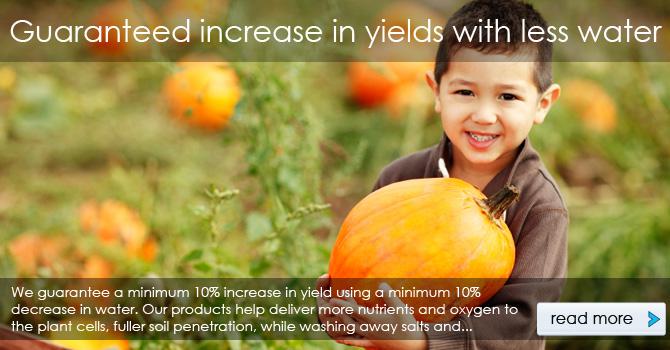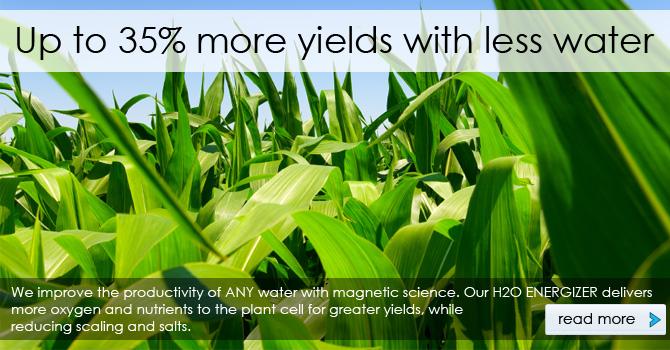Request more information
Benefits to Your Business
Facts and benefits of university researched magnetic water treatment can be explained by a phenomenon called "Magnetic-Hydromagnetic resonance" under the action of Lorentz's force. The key parameters that influence the magnetic treatment are the velocity of water flow in the pipe and the intensity of magnetic induction.
Magnetic treatment to your water supply can:
- Reduce water usage by minimum 10% and up to 30%
- Reduce fertilizer usage
- Reduce pesticide and herbicide usage
- Increase yields by at least 10%
- Improve taste of produce
- Increase shelf life of produce
- Improve soil pH and remove/dissolve impurities from soils year after year
- Increase nutrient content in produce
- Increase seed germination percentage and speed of seedling emergence
- Increase fine root growth
- Drastically reduce heat stress
- Increase water flow
- Saving energy and resource
- Prevent and remove scaling from irrigation pipes
- Makes traditionally unusable saline water usable and increases water productivity
- Soil desalinization takes effect in the first year 1/1.5 meters
- Increase productivity and reduce disease in live stock and general animal breeding
- Increase weight and reduce disease in aquaculture industry
It is a scientific fact that the use of Omni’s magnetic water devices to treat irrigation water will improve water productivity and thus lead to significant water savings. In the context of current and future water scarcity, even a small savings in irrigation water (conservatively say 5%) through magnetic treatment will translate to huge savings nationally.
Scientific studies have shown Omni’s magnetic technology can be put in practice by farmers to improve water productivity, save water, minimize the occurrence of TDS and metals and sustain the health of the environment. The technology has proven to make use of lower quality waters (effluent and saline water) more sustainable and overall will augment water supplies for agricultural purposes. In general, the use of Omni’s technology will help improve long-term viability of the agricultural industry and sustainable economic development in both urban and rural areas.
Magnetically treated water can:
- Save a significant amount of water
- Improve water productivity
- Increase yield produced per gallon of water used
- Improve quality of produce
- Increase shelf life
- Enrich taste
- Minimize the salinity effect and cleanse soil
- Reduce chemical usage
- Sustain the health of the environment.
Water saving opportunities
Agriculture, our economy’s most dominant water user, also presents our economy with the potential to save large quantities of water and help to shift the paradigm in water usage and treatment.
The implementation of magnetic water treatment technology by the irrigation sector will be a significant benefit to the global environment, not to mention a significant benefit to the farmer.
Typically only 10% of the water stored within the root zone is available for plant uptake as over 90% of the water stored within the root zone is consumed by evaporation and transpiration during growing season.
University research of Omni’s magnetic technology shows a reduction in plant transpiration by as much as 32% and farmers confirm elimination of surface runoff and up to 30% water saving and increased productivity after their systems were fitted with Omni’s magnetic technology systems.
Examples
Greenhouse Experiment
Pea and celery seeds were initially sown in seedling mixture in early May and later transplanted in pots (14 inch pots) containing measured amount of soil. Pea and celery plants (two plants/pot) were transplanted on 4th and 9th of May 2007 respectively. Soil moisture in all the pots was maintained at the same level by applying measured amount of water. Initially normal tap water was applied for 10 days in all the pots irrespective of treatments to avoid the salt injury while seedlings are recovering from the initial ‘shock' of transplantation. Thereafter, water application was commenced as per treatments both in pea and celery pots. The temperature in the glasshouse was maintained at 20° C during day and 15° C during night. Pea plants were harvested by end June, however the celery plant experiment is still continuing for another month.
Another experiment involving magnetically treated and non-magnetically treated normal tap water, effluent recycled water, salty water with 500 ppm sodium chloride and 1000 ppm sodium chloride on snow plants commenced in the third week of July and is well in progress. This experiment is expected to demonstrate in further depth the effects of magnetic treatment and different sources of water on water saving and water productivity of snow pea plants and results will be described in final report.
Seed Germination Experiment
This preliminary test gave some encouraging results as to the effects of magnetic treatment and early germination of snow pea and chickpea seeds and improved vigor of seedlings.
Grain Yield
Irrigation with magnetically treated recycled water and high salt water (3000 ppm sodium chloride) showed yield advantage of 8% and 4% respectively over non-magnetic treatment.
Straw Yield
Irrigating pea plants with magnetically treated recycled water and high salt (3000 ppm sodium chloride) water resulted in a straw yield increase of 9% and 4% respectively over without magnetic treatment.
Water Productivity Based on Grain Yield
Irrigating pea plants with magnetically treated water tended to improve water productivity based on grain yield (mg grain produced per ml of total water used in ET[CH1] )
Water Productivity Based on Total Biomass
Like water productivity based on grain yield, irrigating pea plants with magnetically treated water also tended to improve water productivity based on total biomass production (mg biomass produced per ml of total water used in ET)
Transpiration
Irrigating pea plants with magnetically treated water significantly reduced the water used in transpiration of pea plants (Figure 6). There was 32%, 18% and 13% reduction in transpiration by irrigating pea plants with magnetic treatment of tap water, 1500 ppm salt water and 3000 ppm salt water respectively compared with non-magnetic treated water.
Conclusions
Irrigating pea plants with magnetically treated water tended to reduce the total water use in ET and improve the water productivity based on grain yield and total biomass production compared with non-magnetic treated water irrigation.
Magnetic treatment of water significantly reduced water used in transpiration of pea plants, and these effects were more pronounced in tap water.
Grain and biomass production per unit of water used in transpiration was also increased in pea plants irrigated with magnetically treated tap water.
The celery plant experiment is still in progress and expected to be harvested soon. Initial results of celery plants up to the first of August 2007 indicate slight reduction in water used in ET and transpiration in magnetically treated water compared with non-magnetically treated water.
Another experiment involving magnetically treated and non-magnetically treated normal tap water, effluent recycled water, salty water with 500 ppm sodium chloride and 1000 ppm sodium chloride on snow pea plants was transplanted in the third week of July and is expected to reflect real differences if any of magnetic treatment and different sources of water on water saving and water productivity of snow pea plants.
We are also testing the impact of magnetic treatment of seed and use of magnetic treated water on germination and initial growth of snow pea and chickpea seedlings. The detailed results will be given in a final report and posted on this web site.
Copyright© Quantum Biotek Pty. Ltd. 2025. All rights reserved
1300 66 07 88


